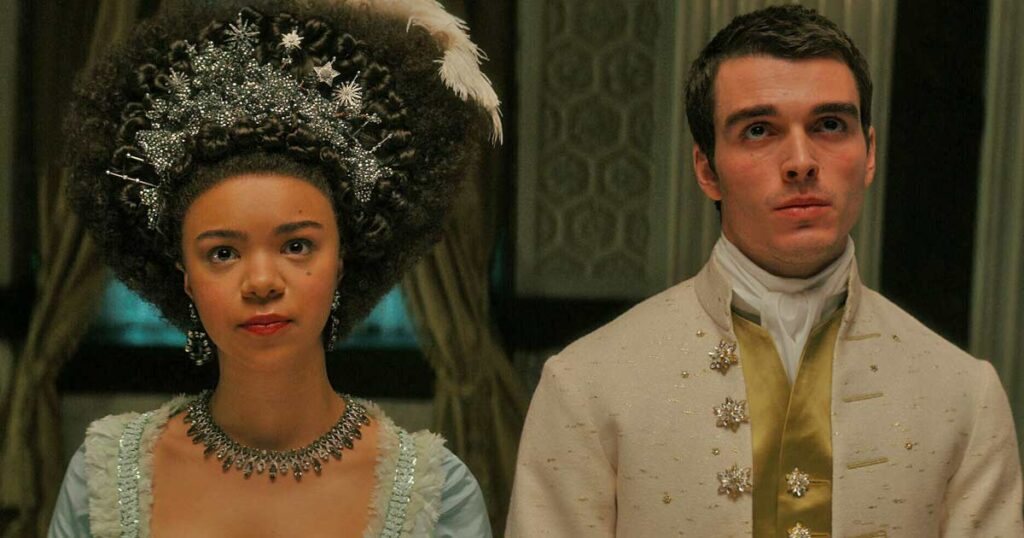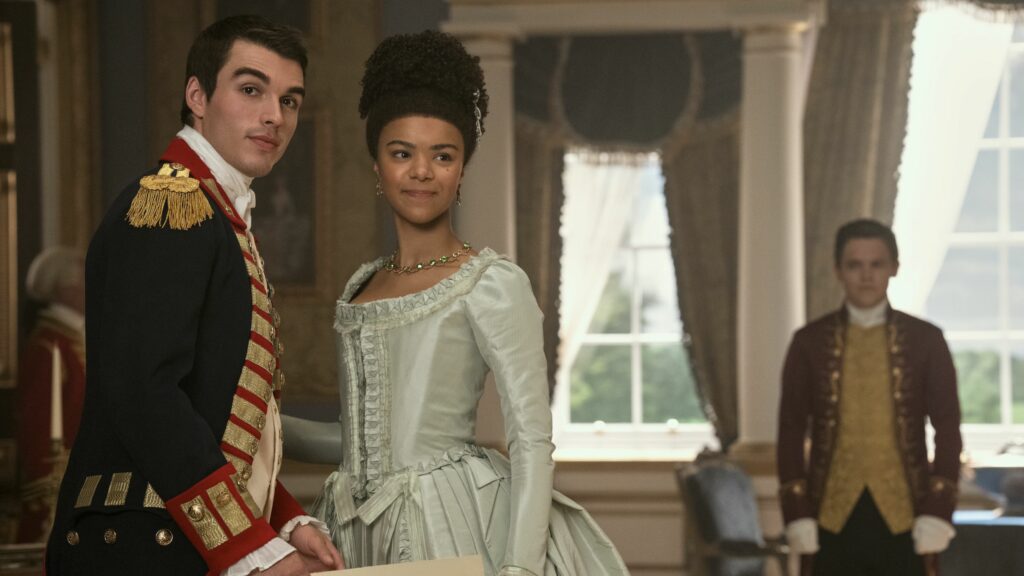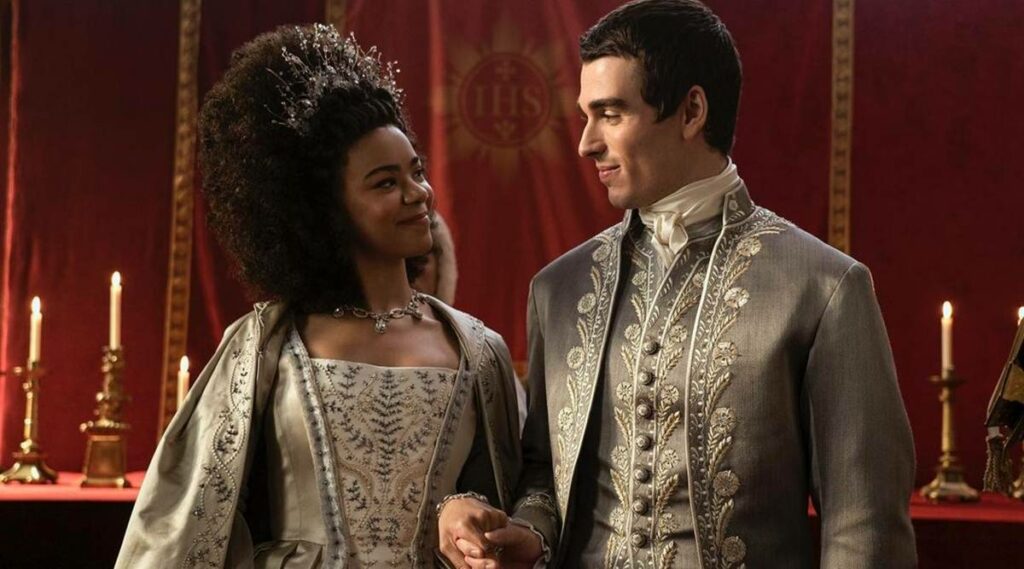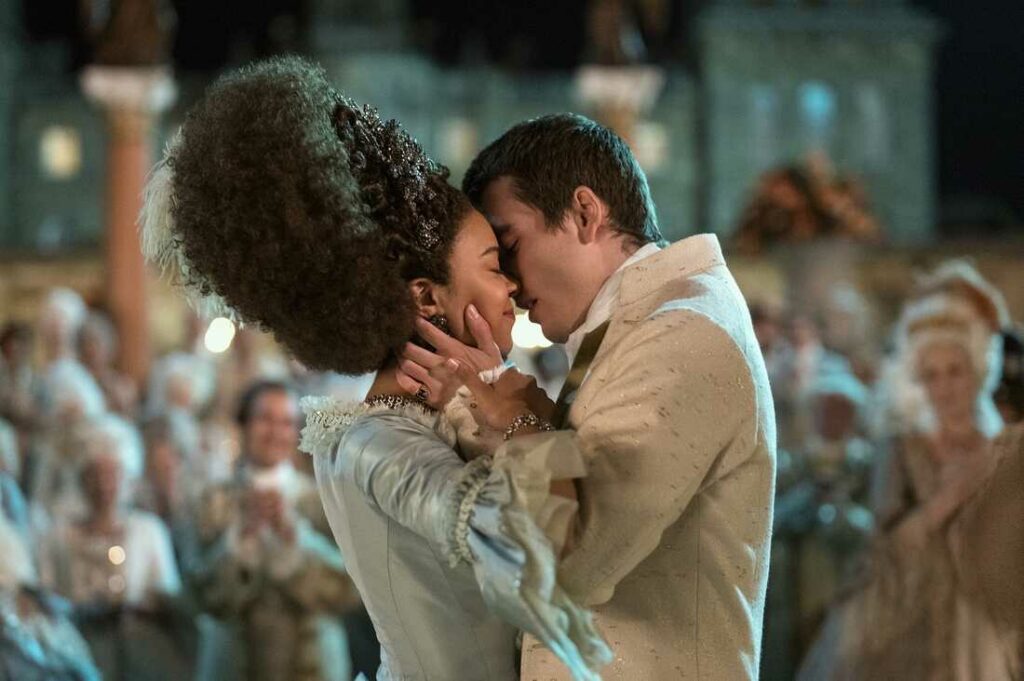Spoiler alert: This is a review of the show ‘Queen Charlotte: A Bridgerton Story’ and discusses the plot.
Trigger Warning: This article mentions marital rape.
The Netflix show Queen Charlotte: A Bridgerton Story infuses period drama escapism into modern-day sensibilities and offers some brilliantly written female characters – those with agency, flaws, and the perseverance to question the norms thrown at them and fight for what is theirs.
Women are tasked with navigating a society that places heavy restrictions on them, and Charlotte’s life is the tale of a woman rising to power and standing up for herself. In this Bridgerton spin-off, Director Tom Verica draws parallels with the Regency-era Queen (played by Golda Rosheuvel) as she navigates different roles as a wife and mother as well as her duties as the monarch, which are certainly more than choosing the incomparable bachelorette aka ‘diamond’ of the season.
A Shonda Rhimes creation, the series is led by India Amarteifio as the Young Queen Charlotte and it takes a humanising look at the trajectory of her marriage with King George III and her reign as Queen of England. Women are tasked with navigating a society that places heavy restrictions on them, and Charlotte’s life is the tale of a woman rising to power and standing up for herself. In this Bridgerton spin-off, Director Tom Verica draws parallels with the Regency-era Queen (played by Golda Rosheuvel) as she navigates different roles as a wife and mother as well as her duties as the monarch, which are certainly more than choosing the incomparable bachelorette aka ‘diamond’ of the season.
Women and their bodies
Netflix’s latest addition to the Bridgerton universe raises pertinent questions on society’s obsession with seeing women merely as heir-producing machines and nothing beyond that. Sex is either referred to as a chore or marital duty to the crown. The discourse on female pleasure stands missing. No one wishes to address the strains the female body goes through during pregnancy and the toll it takes on the mind and body.

To add to this is a deeply uncomfortable dialogue where a pregnant Queen Charlotte is gaslighted by her loving brother for being ‘emotional’ about feeling trapped in the lonely royal household. Shrugging off any bodily autonomy that exists, he tells her that her body is not her own, the child that her body is growing is not hers. And I quote Duke Adolphus, the Queen’s brother and sole guardian, “Inside you ripens the fruit of England, and until that fruit is ripe, your body is but a… tree”. Well, what do they say, it’s screaming patriarchy!
Strong female characters
If there’s one thing Queen Charlotte stands out for, it has to be the origin story of Agatha Danbury. Young Lady Agatha Danbury, played to perfection by Arsema Thomas, comes across as the most powerful character of the show – a woman who holds her ground, chooses her battles and fights them. Her storyline is rooted in intersectionality as she contends with the oppression of being Black and a woman and the struggles she faced.
At a time when society expects impoverished widows to either remarry or seek the kindness of a male relative, Agatha Danbury chooses to fight, both for herself and for her people. A storyline fearlessly grounded in both racism and sexism, we love to see a strong resilient female character contest her way out of the shackles of patriarchy.
Young Agatha Danbury was brought up to be the wife of Lord Danbury and finds herself trapped in a loveless marriage enduring repetitive marital rapes. (Yes, we’re calling it as it was.) When thrusted into widowhood, she is saddled with the burden of “what it means to be a woman not tied to a man” and the possible loss of her title and estate.

At a time when society expects impoverished widows to either remarry or seek the kindness of a male relative, Agatha Danbury chooses to fight, both for herself and for her people. A storyline fearlessly grounded in both racism and sexism, we love to see a strong resilient female character contest her way out of the shackles of patriarchy.
Depiction of mental health in Queen Charlotte: A Bridgerton Story
Queen Charlotte centres around the deteriorating mental health of the King and how the Queen navigates through it all. Young King George, played by Corey Mylchreest, is a vulnerable man tackling an intense mental health struggle along with the pressure that comes with being the monarch of Great Britain and Ireland, 18th century’s most powerful nation. Through his character’s story arc, the show serves a sensitive insight into the lives of people living with mental health conditions, who falsely believe that they do not deserve to be loved or have to ‘fix’ themselves in order to be worthy of someone’s love.
George has been defined by labels for the most part of his life – from being the ‘royal heir’ to the monarch at a young age, up until being referred to as the ‘Mad King’ by his people, the Parliament and seemingly much of history. But for Charlotte, he wishes to be just George, a farmer at his core who is passionate about agricultural inventions and astronomy. Notably, it was during the actual King George III reign that rural and urban areas of the United Kingdom were spurred by industrial innovations of the time. A humble ode to the show’s ‘fiction inspired by fact‘ essence, indeed!

George desperately loves his wife but believes himself to be dangerous to the Queen due to his hidden mental health struggles and willingly resorts to extreme measures to become better, ‘normal’ as he calls it, to have a chance of future happiness with her. The show’s portrayal of the King and his mental health struggle is rather humane, especially when compared to other historical accounts which are highly sensationalised and lack sensitivity.
Queen Charlotte, on the other hand, tries to steer away from the “I can fix him” tropes that are commonly written on to women and is shown to support George for whoever he is, however she can. It’s wonderful to see a show depicting how much love can help make things just a bit better. It doesn’t fix it, but it can help, and that matters.
Queen Charlotte, on the other hand, tries to steer away from the “I can fix him” tropes that are commonly written on to women and is shown to support George for whoever he is, however she can. It’s wonderful to see a show depicting how much love can help make things just a bit better. It doesn’t fix it, but it can help, and that matters. Although very slightly, the writers also attempt to contextualise mental health conditions that can stem from childhood trauma, as in the case with George and his upbringing in a rather lonely royal family and a vicious grandfather, his predecessor and the former King.
The show’s depiction of mental health illnesses and more so, its treatment and knowledge in the Georgian-era is not only harsh but heartbreaking. When Doctor Monro was introduced as the King’s treating doctor, my brain jumped at the excitement that a period drama is finally touching upon psychotherapy or talk therapy as a legitimate way of treating mental health conditions.

The way he takes George into confidence acknowledges his struggles and attempts to offer a space to let out, (and heal) builds up quite assuringly. But merely half an episode later, the extreme switch to physical and torturous ways to ‘cure’ the King’s insanity serves as a harrowing reminder of the era where research on mental health was limited. Sadly, you are just left waiting for the doctor to simply ask George, “You want to talk about it?”
Race amidst the romance
Pivotal to this Bridgerton prequel is a ‘great experiment’, the aristocracy’s attempt to integrate racial diversity in the royal family and to cover up for the “rather darker” skin tone of Queen Charlotte, when she’s first brought to England for the marriage alliance. Spearheading this integration project is a reluctant nobility and Dowager Princess Augusta, the King’s mother grants land and titles to wealthy families of colour. However, even after the peerage, the newly-titled struggle in getting accepted by the Ton as a member of society. Internalised racism and bigoted notions of superiority stall their access to White spaces – a systemic problem that would not be easy to tackle with half-thought policies, right?
Of the many instances used to highlight the stark divide between the old Ton and new members, the Danbury Ball is worth mentioning. Amidst lavish decor and intricate costumes, what stands out is the distinction between dances from the two sides – all members of noble society, similarly privileged but refusing to mingle with each other. The show, however, continues to be classist in its treatment of race and ethnicity with no mentions of the great experiment’s impact on the working class and the marginalised.

The writers also nudge in the influence of euro-centric beauty standards that continue to pervade modern-day pop culture, through references to Queen Charlotte’s paintings which are notably commissioned by the royal family. In her wedding portraits, for instance, the Queen’s skin is made lighter than her actual skin colour in order to make her “glow” as the newly wed. In fact, scholars argue that historical portraiture can not always be an accurate measure to determine the features of historical figures, in congruence with the debate around the Queen’s actual descent.
Female friendships in Queen Charlotte: A Bridgerton Story
In a series that is so much about romantic love, you never lose sight of crucial human needs like friendships and platonic love. Female friendships play a vital role in the process of personal transformation by making space for the narratives of self-discovery — stories that allow women to cope with all that they have lost and gained, and ultimately evolve into more complete and empowered individuals, all while supporting one another.
The intricacies in understanding female agency results in some inordinate moments of female solidarity that sit proudly along the show’s steamy romantic core. In one of the most ardent displays of female solidarity, Princess Augusta schools the young Lady Danbury on the virtues of endurance and seizing control over one’s fate.
The intricacies in understanding female agency results in some inordinate moments of female solidarity that sit proudly along the show’s steamy romantic core. In one of the most ardent displays of female solidarity, Princess Augusta schools the young Lady Danbury on the virtues of endurance and seizing control over one’s fate.
The Princess implies that despite her disdain, she respects Lady Danbury’s strength and wants her to continue fighting for her rights. After all, they are two women who have had to pick up the pieces after the deaths of their husbands and will do whatever they think necessary to ensure their survival and the survival of their children.
The show’s storylines draw incredible parallels with the relevance and irreplaceability of female friendship in the modern world. That’s the thing about friendship, on the show and in real life – it empowers us all.
Queen Charlotte’s friendship with Lady Danbury is another beautiful, and arguably important relationship to witness as the series unfolds. Lady Danbury instils the importance of the Queen’s power, the first of her kind, into a naive Charlotte, while the latter finds comfort and honesty in Danbury during her times of loneliness. Women, with visible privileges and power structures, do not tear each other apart but rather are an important part of their lives helping each other out in true essence.
In a rather funny scene, Lady Danbury also draws diagrams to educate the Queen about intricate “marital details”, basically, how to have sex and other stuff that mothers never get around to explaining. Turns out, Regency-era or the 21st century, sex education has been lacking since forever!
Exploring sexuality, intimacy and more
How often do we think about desire and love in the context of elderly people? Is dealing with heartbreaks and discovering sexuality limited to the province of the young?
If you take a brief flashback into the Briderton-verse, you’ll recall how the lives of older, mature women of the Ton revolved solely around society gossip and matchmaking. This time, the creators take a refreshing detour and focus on the stories of the older women and delve into their own feelings, romance, desires and struggles. Because honestly, who better to talk about love and loss than the ones who have fared through it all?
Queen Charlotte transcends into the repressed sexuality of older women while heavily relying on garden metaphors to talk about ‘that which cannot be said’. It allows its older women to explore the sexuality of their characters in a compassionate way, giving two compelling but often peripheral Bridgerton figures a third dimension. In an exceptional sequence, Violet Bridgerton (Ruth Gemmell) confronts her reawakened sexual longing after years of abstinence following the death of her loved husband.
What’s more heartfelt is Agatha Danbury’s assurance that it is okay to want it, which sees her character (played by Adjoa Andoh) hit on the truth of their roles so far in the Bridgerton universe, as pawns for “social chatter and marital schemes”. She tells Violet: “We are full of gossip and story, but as women, we are never the topics of the conversation. Lady Whistledown never writes of our hearts. We are untold stories.”
The show also makes space for queer desire with Brimsely and Reynold’s passionate and duty-driven romance. Netflix’s exploration of Queen Charlotte’s world offers a compelling examination of power, love, and societal expectations and has resonated greatly with the adoring audiences of the Bridgerton universe. At the core of Queen Charlotte is an acknowledgement of a woman’s need to be seen, heard, and accepted for who they are.
It also delves deeper into Agatha’s journey with sexual desire – from viewing sex as a chore which was always done at the whims of a man to redefining how she views intimacy and attempts to heal her associated trauma.
The show also makes space for queer desire with Brimsely and Reynold’s passionate and duty-driven romance. Netflix’s exploration of Queen Charlotte’s world offers a compelling examination of power, love, and societal expectations and has resonated greatly with the adoring audiences of the Bridgerton universe. At the core of Queen Charlotte is an acknowledgement of a woman’s need to be seen, heard, and accepted for who they are.
About the author(s)
Aishwaryaa is a content producer with a passion for storytelling. She is a keen explorer of digital media and learner of feminism, seeking to drive change and social impact through her work. Her interests lie in culture, gender, and human interest stories. You can find her on Twitter, Instagram and LinkedIn.




